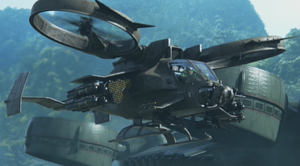AVA-55 Falcon
| AVA-55 Falcon | |
|---|---|
 An AVA-55 Falcon hovering over the jungles of Kirkaji. | |
| General information | |
| Type | Attack Helicopter |
| Manufacturer | Rusino Heavy Industries |
| Designer | Martin L. Glushki |
| Status | Active |
| History | |
| Manufactured | 2992-3282 |
| Introduction date | 12 April 2993 |
| Retired | 5 November 3283 |
The AVA-55 Falcon was an atmospheric attack VTOL used by the Concordian Armed Forces from the late 30th Century until the Late 33rd Century. Noted for its durability and payload, the AVA-55 was well respected by troops and feared by its enemies and it became to be one of the most well known vehicles in the universe after its extensive usage throughout the Milky Way Conflict. The AVA-55 utilised a ducted-fan propulsion system that gave it incredible manoeuvrability and speed, though it had to be transported into an atmospheric environment first and was incapable of operating in vacuums, relegating the VTOL to a purely ground support role on atmospheric bodies.
Design
The AVA-55 Falcon was designed by Martin L. Glushki, who set out to meet a need by the Concordian military for a highly manoeuvrable, resilient and hard punching close in support VTOL. Thus the Falcon was designed to feature heavy armament while utilising powerful propulsion.
Propulsion and power
The Falcon featured a twin ducted-fan propulsion system, supplied with a primary microfusion reactor that also provided power for the rest of the electrical systems of the aircraft. The reactor supplied power to the twin contra-rotating turbines that spun the carbon nanocomposite ducted fans at over 6000 RPM. The ducted fans were located within a housing that could rotate axially forwards and backwards, while the fans themselves could independently rotate laterally from left to right, giving a large amount of manoeuvrability to the aircraft in every direction. Due to the complexity of controlling the ducted fans, it was automatically calibrated and adjusted by an on board artificial intelligence.
Variants
AVX-55 Specialised variant developed with exoatmospheric capabilities. At the expense of some of the exterior weapons hardpoints, the AVX-55 featured a modified repulsor drive that could operate in both atmospheric and vacuum conditions. The ventral hull shielding was also improved for thermal protection from atmospheric entry.
Specifications
General characteristics
- Crew: 1
- Length: 16.78 m
- Wingspan: 11.2 m
- Rotor diameter: 4.25 m
- Height: 4.02 m
- Empty weight: 6026 kg
- Loaded weight: 10,261 kg
- Max. takeoff weight: 12,921 kg
- Fuel capacity: 100 g of standard fusion mix
- Powerplant: 1 x Weyville Co. MFR-25 microfusion reactor x Rusino AVDF-10 ducted fan engines
- Thrust: 1000 kN (AVX-55 with exoatmospheric repulsor drive)
Armament=
- Guns: 2 x 35 mm EAG-11 rotary cannons (2000 rounds each - refabricatable)
- Hardpoints:
- Four hardpoints on the primary armament pylons with two hardpoints on the pylon edge
- Two hardpoints on the secondary forward armament pylons
- Missiles:
- Up to 16 AGML-179 Strife laser guided missiles in quad mounts
- Up to 128 rockets mounted in four rocket pods
- Up to four AAMD-99 Whiplash dogfight missiles